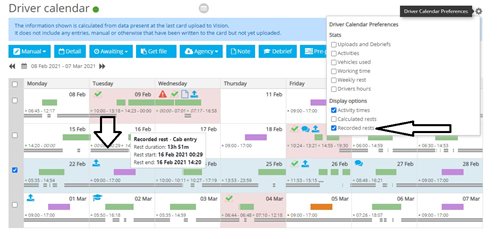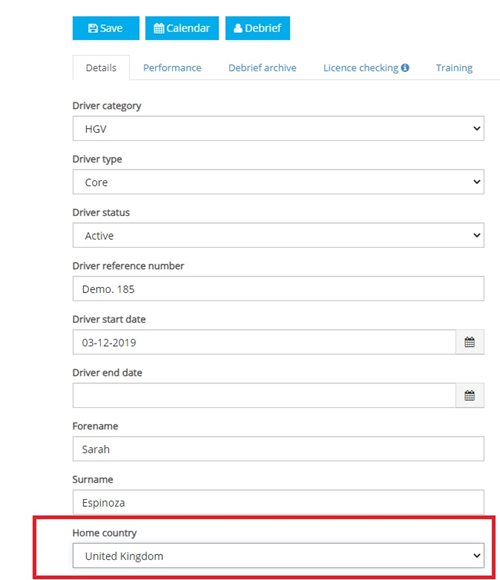Drivers hours and the mobility package
Thursday 16 September 2021
In August 2020 some changes were made to drivers hours and tachograph legislation through the mobility package. Whilst the changes have been in place for some time we felt it important to highlight what has changed in Vision to support you in remaining compliant.
Recording other work
The new legislation states that a driver is obliged to keep a full record of all their activities. A letter of attestation would not be acceptable to cover long periods of non driving activity. Furthermore, DfT has emphasised that while a driver is only required to carry records of the current day and previous 28 days for inspection at the roadside, an operator would be expected to be able to produce comprehensive records for all drivers at their premises.
To help users of Vision to identify where drivers have recorded rest periods, we have added a feature on the driver calendar to show where these activities have been recorded either by leaving a driver card in the vehicle unit or by using the cab entry to record activities.

On this example you can see where a driver has used a cab entry to record their rests to the driver card, but on the 11th February and 18th February it is clear that no activity has been recorded to the driver card.
When a driver records rest by leaving the card in the vehicle unit, a similar line will show in green:

In addition to this, the Recorded rest exception report, under the Management reporting group in Self service reports will also document where recorded rests have not been displayed:

Further to this, we will shortly be releasing a Manual entry dashboard which will also clearly display drivers with unexplained gaps between traces.
Two reduced weekly rests in a row (International drivers only)
Drivers engaged in international transport are able, where necessary to take two reduced weekly rest periods in a row in every four- week period provided that the driver in any four consecutive weeks takes at least four weekly rest periods, of which at least two shall be regular weekly rest periods. The driver must start the reduced rests outside of the member state of establishment in order to qualify for the extended reduction in weekly rest ruling. If the first reduced rest begins inside the driver’s place of residence, then the standard rules will apply. After two consecutive reduced weekly rest periods, the compensation for both reductions must be taken en bloc before the next weekly rest period. Guidance from DfT indicates that the compensation rest must start before the end of six 24-hour periods after the second reduced weekly rest finished and that compensation rest must be taken at ‘home’.
In order to accommodate this change the driver profile now has a field that allows you to add the drivers base country.

Once this is added the drivers’ hours engine can then identify which country the driver is in when they start a reduced weekly rest by checking the places table on the card. This is only populated when the driver either ejects or inserts a card or navigates the vehicle unit menu to acknowledge the end or start country when leaving a card in to record rest. When the driver satisfies the rules as explained above, taking 2 consecutive reduced weekly rests starting away from base country, then no EWR1 will be given. Where compensation doesn’t take place before the end of the next six daily driving periods (or 144 hrs) following the second weekly rest reduction then a new comment will be added for EWR3 code:
EWR3- Failure to compensate for consecutive reduced weekly rests taken while engaged in international transport starting xx time xx date Shortfall of xx h xx mins not compensated en bloc before the start of the next weekly rest period.
Ferry rules update
Where a driver accompanies a vehicle that is transported by ferry or train and takes a regular daily rest period, that period may be interrupted twice by other activities not exceeding one hour in total (access to a bunk or couchette is a pre-requisite).
The revised rules allow the interruption to also be applicable to reduced weekly rest periods, under the same conditions:
• Rest period may only be interrupted twice.
• The interruption cannot exceed one hour in total.
• The driver must have access to a bunk or couchette, or, with the amendment, a sleeper cabin. A regular weekly rest may now also be interrupted only where the ferry or train journey is scheduled for more than eight hours and the driver has access to a sleeper cabin.
Whilst Vision has no way to see if the driver has access to a sleeper cabin the rule has been added to allow a ferry crossing to interrupt a weekly rest provided the rules are met.
We advise that in order for the correct analysis to be applied to a rest interrupted by a ferry crossing the driver should apply ferry mode on the vehicle unit, only when the vehicle is parked on the ferry following embarkation. Vision will analyse any activities prior to and after the rest as ferry interruptions and provided they total 1 hour or less will assign these drive and work activities to the end of the previous shift and start of the next shift.
In this example we see the ferry interruptions starting at 19:32 and 22:15. These are highlighted in red:

This is the following day (10th July) where 24 hrs from the start of the shift on 9th July (06:53) is marked in black

Adding together the periods of rest we can calculate the following:
Rest 1 starting at 16:44 ending at 19:32= 2hrs 48 mins
Rest 2 starting at 19:34 and ending at 22:15= 2hrs 41mins

Rest 3 starting at 22:58 on 9th July ending at 06:53 on the 10th July = 7hrs 55mins

Checking through the ferry rules:
- Are there 2 or less interruptions? – Yes- Criteria met!
- Do those interruptions total 1hour or less - Yes, total 45 mins- Criteria met!
- Is the rest in 24 hrs at least 11 hrs- Yes- 2:48 + 2:41+ 7:55= 13:24 – Criteria met!